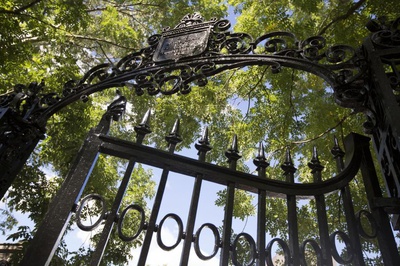
News
News Flash: Memory Shop and Anime Zakka to Open in Harvard Square

News
Harvard Researchers Develop AI-Driven Framework To Study Social Interactions, A Step Forward for Autism Research

News
Harvard Innovation Labs Announces 25 President’s Innovation Challenge Finalists

News
Graduate Student Council To Vote on Meeting Attendance Policy

News
Pop Hits and Politics: At Yardfest, Students Dance to Bedingfield and a Student Band Condemns Trump
Robot Mimics Squid Movement
Flexible bots could someday help with rescue missions

A team of Harvard scientists led by chemistry professor George M. Whitesides ’60 has developed a flexible robot inspired by animals without skeletons.
The new robot is more resistant to damage and more maneuverable than existing metal robots, Whitesides said.
The device is made of a flexible elastomer similar to the caulk used to seal bathtubs. Whitesides said it represents a new class of robots that can provide additional capabilities without necessarily replacing the conventional robot.
Adam A. Stokes, a postdoctoral fellow who works with Whitesides, said the robot, whose development was funded by the Pentagon, could potentially be used for applications ranging from search and rescue to surgery.
“Our soft devices have none of the elements that would comprise a traditional robot,” Stokes said. “This gives them several unique aspects: low cost, flexibility, and agility.”
The five-inch-long robot design mimics the flexibility of squids but assumes a crawling, human-like form. Its four limbs are controlled by pumped air.
“These robots are in some ways more resistant to damage than structures that have metal rods and strings in them,” Whitesides said.
The current model can move but cannot perform other functions like picking up items and turning, and it is still tethered to a gas pump. But the researchers are investigating ways to give the robot more of the capabilities of conventional robots.
“Ultimately, we’re looking for robots that don’t have a tether, a pressurized gas source. It would be nice to think about making devices that can move freely,” Whitesides said. “There’s no question that one can combine functions.”
Whitesides said that the team is looking into integrating visual capabilities into the robot.
The team’s most recent model comes after years of research. “We’ve been working at this for a few years now,” Whitesides said. “Our first publication was a year ago, and that device just picked something up—it didn’t move.”
Whitesides’ team is not alone in researching flexible robot design. Similar projects are underway at MIT and Tufts.
“I think the robotics community is just beginning to wake up to the idea of using elastomers as components for making robots,” Whitesides said. “We are all collectively beginning to develop this class of objects to see what they can do.”
Want to keep up with breaking news? Subscribe to our email newsletter.
From Our Advertisers

Over 300+ courses at prestigious colleges and universities in the US and UK are at your disposal.

Where you should have gotten your protein since 1998.

Serve as a proctor for Harvard Summer School (HSS) students, either in the Secondary School Program (SSP), General Program (GP), or Pre-College Program.

With an increasingly competitive Law School admissions process, it's important to understand what makes an applicant stand out.

Welcome to your one-stop gifting destination for men and women—it's like your neighborhood holiday shop, but way cooler.

HUSL seeks to create and empower a community of students who are seeking pathways into the Sports Business Industry.
